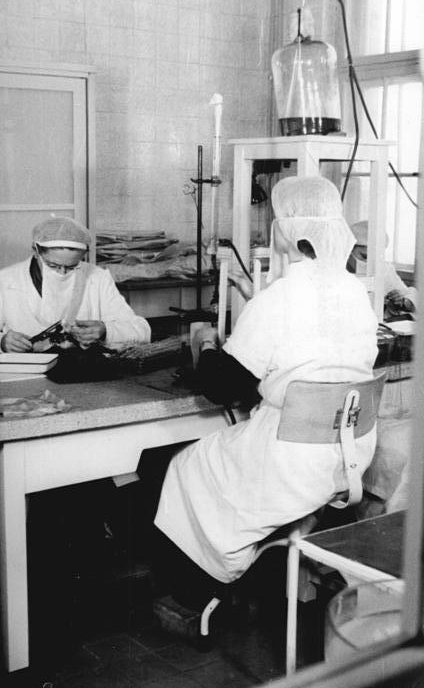
Humanity has a short memory. It helps people not to live in permanent fear. And the longer it has been since the last case, the less aware we are of the risk.
Epidemics are nothing new, Corona is just the latest in a whole series of mass sicknesses that hit Germany.
Who still remembers the Hong Kong flu epidemic between 1968 and 1970 that killed over a million people worldwide? In the Federal Republic alone, around 40,000 people died. There had already been several pandemics in the 20th century. During the Spanish flu, after the First World War, people in Western countries were warned to stay at home, but few obeyed. At the time of the Asian flu and the Hong Kong flu, people were limited to getting through the crisis, there was no general curfew. Today, people react much more sensitively. Increased life expectancy may be one of the reasons…
So, pandemics are nothing new, but between 1945 and 1989 there was a peculiarity: diseases and prevention became weapons in the arsenal of propaganda in East and West. Outbreaks in the other Germany were commented on in the media, always with reference to the respective state doctrine as the supposed cause.
At the end of March 1962, there was an outbreak of bacterial dysentery in the GDR. By the middle of the last week of March at the latest, it was known that the capital of the GDR had become the scene of the most widespread epidemic to hit the territory of the GDR since the end of the war.
The MfS was alerted, and the East Berlin epidemic department’s search and countermeasures apparatus went into action. The result was a political disaster. The cause was butter contaminated with dysentery bacilli that had been sold in four East Berlin districts in the week before last in March.
The disease spread explosively through contact infection. As early as 1 April, the capacity of East Berlin hospitals was no longer sufficient. Auxiliary hospitals had to be set up. In addition to trained staff, students and People’s Police officers were used as nurses.
It was not until 4 April, more than a week after the beginning of the wave of illnesses, that the government broke the silence. Only on that day did the SED announce the epidemic.
On 8 April, an entry and exit ban was imposed on Berlin, but due to lack of control it did not take effect and it was too late anyway. Large parts of the GDR were now affected. The number of people who fell ill rose to 75,000, and the first deaths were reported.
Nevertheless, the SED officials did not want to close schools and kindergartens. They did not want to give the western propagandists – such as the “Bild” newspaper, which claimed to have already discovered 100,000 sick people and 40 dead – any more excuses to retaliate for the campaign that had been sparked in East Berlin on the occasion of a West German smallpox outbreak.
Of course, this was not admitted. Rumours spread that China was the country of origin.
The propaganda machine started up. Large-scale articles praised the exemplary performance of doctors in the socialist system.
Since the death toll remained low, the diarrhea-stricken Berliners were helped through the crisis by their sense of humor. The joke circulated: “Everything will get better: East Berlin is the Ruhr.”
For the first time, RIAS and other West Berlin media could see something positive in the Berlin Wall. It had reliably kept the epidemic out of West Berlin. And this despite the fact that in 1962 it did not yet have the dimensions it would later have. In The Wall Museum you can see the installations of the time.
The disease outbreaks in the West offered excellent targets for SED propaganda. Especially since Bonn, for dogmatic reasons, refused help. Willi Stoph, deputy chairman of the Council of Ministers, offered three million vaccine doses to West Germany in 1961 – as a humanitarian gesture for the polio-stricken Ruhr area, where the crisis was already acute with 42 dead. Adenauer refused. And the SED reported the “no”. The picture was clear; here healthy laborer’s in the socialist state, there dangerous epidemic areas and high disease rates in capitalism.
Shortly before the Wall was built, GDR television warned of imported pathogens from the West. Traveler’s from the West were even offered vaccinations free of charge.The GDR itself mostly worked with a cover-up.
In April 1963, a man in Aschersleben showed smallpox symptoms. It was an African who had been living in the GDR for half a year. Globalization as we know it today, and with it the rapid accessibility of all areas of the world, were not known at that time, certainly not in the sealed-off GDR.
There had been local outbreaks and deaths in the Federal Republic, but not in the GDR. Smallpox vaccination was compulsory in both parts of Germany. The patient in Aschersleben was isolated and all contacts were traced. 1,700 people were vaccinated as a precaution.
In the SED media, the action was justified by an outbreak of chickenpox.The GDR experts waited until the laboratory results were available to report the outbreak to the World Health Organization. After a few days, the laboratory gave the all-clear: it was not a smallpox infection.
A few months later, an internal fly crew reported a possible smallpox infection. After landing in Berlin-Schönefeld, a woman was immediately isolated and taken to a clinic. Passengers and crew had to remain on the plane. and later taken to a temporary isolation ward. Fortunately, it was a false alarm, a strong reaction to the smallpox vaccination. Again, there were no media reports about the background.
The MfS reports on the incident showed serious deficiencies in the health system. There was a lack of a special hospital for epidemic cases and isolation facilities at the airports. A hospital was planned in Berlin-Buch. The plan remained unchanged.
The GDR was lucky when smallpox broke out in Kulmbach, Franconia, in autumn 1965. A pensioner from the GDR returned home and was immediately vaccinated again – as were all her contacts in the GDR. There were no contagions in the GDR.
In 1972 there was another case of smallpox in the Federal Republic. The GDR was alarmed, the State Security took over. The available vaccine was controlled. Up to 50,000 doses were immediately available, within 24 hours up to 1.4 million doses. The SED leadership was vaccinated. Those entering the country were subjected to more intensive controls. And in addition, the GDR established contact with the health authorities of the Federal Republic. The quarantine measures in the Hanover area had worked. Over 600 people in the vicinity of the sick guest worker were isolated and 65,000 newly vaccinated.
The GDR also acted. A woman from Hanover had travelled to Rostock. She was assessed as a direct contact person and placed under strict house arrest. Then the border guards reported that her husband had also entered the country. In the middle of the journey, the train to Rostock was stopped, but the MfS people could not find the wanted man – the MfS border guards had given a false name. Later they found the husband, who was also placed under house arrest.
Again, an evaluation was carried out. Imported vaccination pistols had proved necessary. However, there was only one per GDR district and, according to the report, “some of them were already very worn out”. Spare parts were rare, and in-house production “has not yet been successful”.
To prevent smallpox epidemics, the GDR stuck to its compulsory vaccination, even though there was vaccination damage. Every year, the health authorities recorded one or two deaths and a few cases of brain inflammation as a result of the vaccination. This was considered acceptable. The case of the Yugoslavian guest worker remained the last recorded case of smallpox in the whole of Germany.
In 1979, the World Health Organization announced the end of smallpox. Thus, they were officially eradicated worldwide – a great success of modern medicine.
Public health as a result of the superiority of the socialist system – that was what the GDR was all about with vaccination. The slogan was: “Socialism is the best prophylaxis”. Vaccinations against smallpox, polio, diphtheria, tetanus, whooping cough, tuberculosis and, from the 1970s, measles were compulsory. Up to the age of 18, adolescents received a total of 20 vaccinations – prescribed by the state.
The coercive state had its advantages. While polio epidemics were still raging in the West in 1960, the centrally administered GDR society had been largely immunized against polio since 1958.
But there was also vaccination fatigue in the GDR. There were spontaneous sick calls before vaccination appointments and refusal of injections by skeptical parents. In some regions, the vaccination rate fell below 50%. The SED reacted in its own way – with permanent vaccination centers and mass vaccinations in holiday camps, schools and companies.
At the end of the 1970s, the GDR increasingly fell behind in vaccination Too many vaccination dates made people unruly. There were no combined vaccines. Epidemics, such as measles, which was thought to have been conquered, reached East Berlin again in the 1980s. The GDR’s vaccine production suffered from ancient machines. Ampoules were sealed with ever poorer quality rubber. Despite all health and vaccination programs, life expectancy in the East was almost three years lower than in the West in 1989.
Yet the legend of the exemplary GDR vaccination and health system persists to this day. Back then, it is thought, there could not have been a shortage of protective masks. Yet intensive care medicine lacked modern equipment even in normal operation.



